Cniva › Coatlicue › Ancient Egyptian Science & Technology » Origins and History
Articles and Definitions › Contents
- Cniva › Who Was
- Coatlicue › Who Was
- Ancient Egyptian Science & Technology › Origins
Ancient civilizations › Historical places, and their characters
Cniva › Who Was
Definition and Origins

Cniva (also given as Kniva, c. 250 CE to possibly 270 CE) was the king of the Goths who defeated Emperor Decius (249-251 CE) at the Battle of Abritus in 251 CE. Little is known of him other than his campaign in 251 CE, in which he successfully took Philipopolis, killing over 100,000 Roman citizens and enslaving survivors, lay siege to the city of Nicopolis, and defeated the Romans under Decius, killing both the emperor and his son.
Cniva may have learned strategic skills and tactics in the Roman army, as many Goth warriors were enlisted or served as mercenaries, or could have simply had a natural talent for warfare. Either way, he proved a formidable adversary to Romeand defeated their forces so completely that, after the death of Decius, the Romans had no choice but to allow him to safely depart their territory with all the booty and prisoners he had taken from Philipopolis.
Scholar Michael Grant observes that “in Kniva the Goths had a leader of unprecedented caliber, whose large-scale strategy created the gravest perils the empire had yet undergone” (31). Even so, after the campaign of 251 CE, nothing else is heard of Cniva unless one accepts the theory that he is the same person as King Cannabaudes (also given as Cannabas, c. 270 CE) who was killed in battle, along with 5,000 of his troops, in an engagement with Aurelian (270-275 CE).
This engagement was a decisive victory for the Romans, and if one accepts that Cniva and Cannabaudes are the same man, it would explain why Cniva was able to successfully take a walled city through siege while later Goth armies could not: those with the knowledge and skill for siege warfare were killed in 270 CE.
SPONSORSHIP MESSAGE
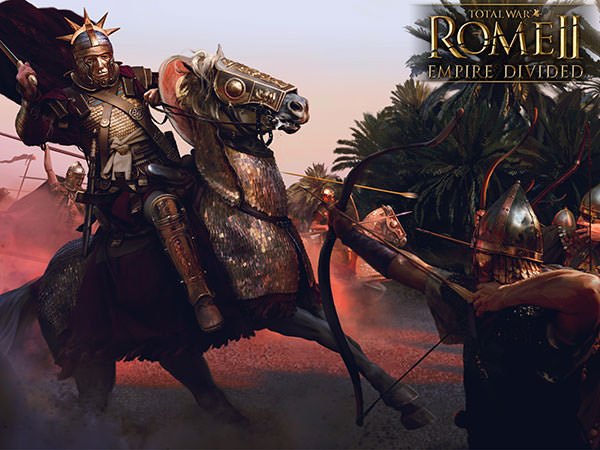
THE CRISIS OF THE THIRD CENTURY
Cniva lived and fought during the period in Roman history known as the Crisis of the Third Century (also the Imperial Crisis, 235-284 CE). This period is marked by almost constant civil war, plague, economic uncertainty, threats of invasion, the breakaway empires under Postumus (260-269 CE) and Zenobia (267-272 CE), and a crumbling and unstable Roman Empire governed by leaders who, for the most part, were more interested in their own personal glory than the good of the state.
The Crisis of the Third Century began with the assassination of the emperor Alexander Severus (222-235 CE). Alexanderwas controlled by his mother who dictated most, if not all, of his policies, and this proved to be a great liability. On campaign with his troops against the German tribes, Alexander followed his mother's counsel to pay the Germans for peace instead of engaging them in battle. This decision was seen by his troops as dishonorable and cowardly and killed him and his mother, raising the commander Maximinus Thrax (235-238 CE) to replace him.
DURING THE CRISIS OF THE THIRD CENTURY, ELEVATING A MAN TO THE POSITION OF EMPEROR WAS ON PAR WITH ISSUING HIM A DEATH SENTENCE.
Between 235-284 CE over 20 emperors would come and go, some quite quickly, as compared with the 26 who reigned from 27 BCE - 235 CE. These rulers are now referred to as the “ barracks emperors ” because they were supported by and largely came from the army. The emperor of Rome had always relied on the support of the military to one degree or another but now such support became vital to an emperor's success and even survival. The difference between these emperors and those who came before – and after – was that they were largely motivated by personal ambition and relied on their popularity with the army, and so continued military support, for their authority to rule.
During the Crisis of the Third Century, an emperor's worth was gauged by immediate, discernable, results; a thoughtful or cautious man would not survive in the position any longer than one inept or cowardly, and yet these judgments were entirely subjective. Throughout this period, it is no exaggeration to say that elevating a man to the position of emperor was on par with issuing him a death sentence; if an emperor failed to produce results, he was killed and replaced by another who showed more promise.
CNIVA, DECIUS, & THE FALL OF PHILIPOPOLIS
This paradigm was adhered to as Maximinus Thrax was assassinated by his troops in favor of the young emperor Gordian III(238-244 CE) who was possibly assassinated by his successor Philip the Arab (244-249 CE) who was then killed by Decius.In each of these instances, the assassination did not take place in a vacuum nor was it orchestrated by a single man. If an emperor fell out of favor with his troops, he could more or less count on a conspiracy forming which would result in his death.
It was in the midst of this unstable period that Cniva marched into Roman territory in 250 CE at the head of an army comprised of different peoples: the Carpi, Bastarnae, Taifali, Vandals, as well as his own Goths. He first attacked the border city of Novae but was driven back by the general (and future emperor) Gallus (251-253 CE). Cniva moved on and lay siege to the city of Nicopolis ad Istrum while the Carpi contingent of his army attempted to take the city of Marcianopolis. Both of these citiesrepelled the attacks, thanks to their fortifications, and Decius arrived with his army to relieve the siege of Nicopolis.

Decius
Decius had been in the Danube region since 249 CE when he deposed Philip and took over as emperor. He had been kept quite busy with various incursions into Roman territory because Philip had stopped the payments to the Goths, SassanidPersians, and various other tribes, initiated by Maximinus Thrax, which had kept them at bay (or, at least, not openly hostile).Decius drove Cniva's forces from Nicopolis but did not decisively defeat him. Cniva led his forces north, ravaging the country, and was pursued by Decius.
In the north, near the city of Augusta Traiana, Decius paused to rest his army and was attacked by Cniva's forces. The Romans were taken completely by surprise and suffered severe casualties while Decius and his commanders fled the field with whatever they could gather of their army. Cniva gathered what supplies and weapons were left behind and marched again south toward Philipopolis.
He lay siege to the city in late spring 250 CE while Decius was trying to recover his army. Philipopolis was garrisoned by a Thracian force under the command of Titus Julius Priscus (c. 250 CE) which was far too small to defeat the immense force of the Goths and their confederates outside the walls. The Thracians declared Priscus emperor, perhaps to empower him to legally negotiate with the Goths, and he brokered a deal by which the city and its people would be spared if they surrendered without resistance. Once the gates were open, however, the Goths ignored the agreement, and the city was sacked and burned. Priscus was either killed or captured at this time since he is not heard of in later reports.
THE BATTLE OF ABRITUS
Cniva completely looted the city and took thousands of citizens captive. He turned his forces around and headed back for the borders and his homeland with his treasures while Decius was still recovering his forces. Once finally organized and regrouped, the Roman forces again pursued Cniva's army as it moved north toward the border. Cniva, hearing of the pursuit, halted his retreat from Roman territory and took up position in a marshy area near the city of Abritus, a region he seems to have known well.
The Goth leader divided his forces into a number of different units (sources record at least three and possibly seven separate divisions) around a large swamp. His front line was positioned across the far side of the swamp while he and another unit took position behind it; other units were placed on either side. When Decius heard that the Goths had stopped their march and were encamped, he hurried to the site, arranged his forces, and attacked Cniva's front line; the only opposing force he could see.

Gothic Invasion 250-251 CE
The Goths fell back before the Roman forces and took flight through the swamp, drawing Decius and his army after them. The swamp completely nullified any advantages of the Roman formations, and they found themselves trapped and then attacked from three sides by Cniva's army. Decius and his son were both killed and the rest of the army almost annihilated. The commander Gallus, who was now proclaimed emperor, led the remnants of the army out of the swamp and retreated.
Cniva took his men and the booty from Philipopolis and continued on his way home. Gallus has been criticized since for not pursuing the Goths and rescuing the captives, but as scholar Herwig Wolfram points out, he had little choice in the matter:
[Gallus] had to allow the Goths to move on with their rich human and material spoils and even had to promise them annual payments. This is why he is charged to this day with treason and incompetence. But in fact, his actions were forced upon him by circumstances. After the defeats at Deroea and Philippopolis, and especially after the catastrophe at Abritus, the new emperor had no other choice. He had to get rid of the Goths as quickly as possible. (46)
CNIVA AS CANNABAUDES
After Cniva leaves Abritus in 251 CE there is no further news of him. Between c. 253 and 270 CE, however, the Goths were masters of the Danube territories and no Roman emperor could unseat them. They launched ships on the Black Sea and ravaged the coasts as pirates as well as continuing to do as they liked throughout the region. The Battle of Naissus in 268/269 CE was a major Roman victory over the Goths but still did not drive them back from Roman borders.
In 270 CE, however, the emperor Aurelian engaged a large force of Goths under a king whose name is given in the Historia Augusta as Cannabaudes/Cannabas. This was a decisive Roman victory with Goth casualties given at 5,000. Aurelian drove the survivors out of the Balkans and into Dacia, improved the Black Sea defenses and broke Goth power in the region. He then left Dacia to the Goths and returned to his objective of unifying the empire by defeating Zenobia of Palmyra and her powers in the east and then reducing the Gallic Empire under Tetricus I (271-274 CE) in the west.
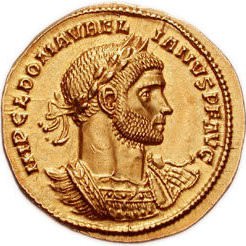
Coin Depicting Roman Emperor Aurelian
It would not be impossible for the same man to have led the Goths in 251 CE and in 270 CE, even if Cniva would have been fairly old by that time. The success of the Goths in their engagements with Rome between 251 and c. 269 CE remained consistent until the Battle of Naissus pit the emperor Claudius II (268-270 CE) against a Gothic force led by an unnamed king who could have been Cniva. Claudius II earned the title Claudius Gothicus for his victory, but his success was actually due to the tactics of his cavalry commander Aurelian who, once he became emperor, would use the same tactics effectively against the forces of Palmyra.
Having defeated the Goth forces once under Claudius, Aurelian seems to have had no problem doing so again in 270 CE as emperor, when he killed the king Cannabaudes and 5,000 of his men. After this engagement, the Goths are pushed into Dacia and lose their hold on the territories they had gained since 251 CE. After 270 CE, the Goths pose no great threat to Rome until almost the middle of the next century. It is likely, therefore, that their previous success was due to a powerful king who was skilled in warfare.
One of the most interesting aspects of Cniva's story is his ability to lay siege to Roman cities. Over 100 years later, the Gothic leader Fritigern (c. 380 CE) was unable to take fortified cities because he lacked siege engines and the required skills. Even though Philipopolis was surrendered by the garrison commander, the siege must have been effective enough to warrant that decision.
Since it is clear that Cniva was able to reduce a large city by force – while Fritigern studiously avoided trying to take cities – it must be assumed that these skills were lost between his time and that of Fritigern. It is quite probable, therefore, that Cniva was the Cannabaudes killed in 270 CE along with any of his commanders who would have also had the knowledge and skills conducive to siege warfare.
Regarding this possibility, the scholar Herwig Wolfram writes:
Although in a formal sense we may be dealing with an equation of two unknowns [specifics of Cniva's and Cannabaudes' lives], a hypothetical solution would be as follows: Cniva, a successful Gothic commander and king of the army in the western tribal territory, is killed in battle as Cannabas against Aurelian. With him perish his people, supposedly five thousand men; the kingship is extinguished. (35)
If Cniva were the king of the Goths defeated at Naissus, it would have made Claudius II's victory all the more glorious in avenging the death of Decius and his son at Abritus in 251 CE. It would seem, however, that if that were the case then some mention would be made of the king's identity. As it stands, the king of the Goths at Naissus goes unnamed and Claudius II's great victory is celebrated simply as driving the Goths from the Balkan borders with no addition of avenging Decius. This has led some scholars to conclude that the Goth king at Naissus could not have been Cniva, but it is possible that the Roman writers simply did not know the king's name.
By the time Aurelian's battle with the Goths is recorded the Goth king is known as Cannabaudes/Cannabas and, although some scholars have suggested that this was Cniva's son, there are no ancient accounts to support that claim. Taking into account the loss of military knowledge evident in Goth engagements following Aurelian's victory in 270 CE, the most probable scenario is that it was Cniva himself who finally fell to Aurelian, an adversary who could best even the greatest of warrior-kings.
Coatlicue › Who Was
Definition and Origins
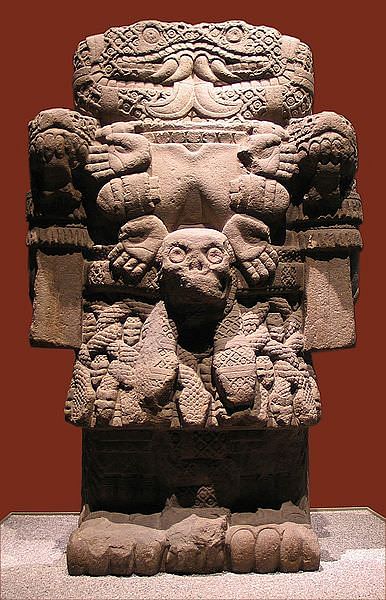
Coatlicue ( pron. Co-at-li-cu-e) or 'Serpent Skirt' was a major deity in the Aztec pantheon and regarded as the earth-mother goddess. Represented as an old woman, she symbolised the antiquity of earth worship and she presents one of the most fearsome figures in Aztec art. Coatlicue was also the patron of childbirth, was associated with warfare, governance and agriculture, and considered the female aspect of the primordial god Ometeotl. The goddess was worshipped in the spring ritual of Tozozontli in the rainy season and in the autumnal hunting festival of Quecholli, when an impersonator of the goddess was sacrificed.
In Aztec mythology Coatlicue was actually a priestess whose job was to maintain the shrine on the top of the legendary sacred mountain Coatepec ('Snake Mountain', also spelt Coatepetl). One day, as she was sweeping, a ball of feathers descended from the heavens and when she tucked it into her belt it miraculously impregnated her. The resulting child was none other than the powerful Aztec god of war Huitzilopochtli. However, Coatlicue's other offspring, her daughter Coyolxauhqui ('Painted with Bells' and perhaps representing the Moon), herself a powerful goddess, and her sons the Centzon Huitznahua ('Four Hundred Huiztnaua', who represented the stars of the southern sky) were outraged at this shameful episode and they stormed Mt. Coatepec with the intention of killing their dishonoured mother. The plot came unstuck, though, when one of the Huiztnaua lost heart and decided to warn the still unborn Huitzilopochtli. Rising to his mother's defence the god sprang from the womb fully-grown and fully-armed as an invincible warrior. In another version the god springs from his mother's severed neck but either way, with his formidable weapon, the xiuhcoatl ('Fire Serpent') which was actually a ray of the sun, the warrior-god swiftly butchered his unruly siblings and chopping up Coyolxauhqui into several large chunks he lobbed the pieces down the mountainside. The myth may also symbolise the daily victory of the Sun (one of Huitzilpochtli's associations) over the Moon and stars.
THE GODDESS FAMOUSLY WARNED THE MEXICA OF THEIR FUTURE DEMISE.
This battle would be commemorated with the setting up of the Templo Mayor at the Aztec capital of Tenochtitlan. The giant pyramid was covered in snake sculpture and even the shadows cast by its steps were designed to reference Mt. Coatepec. A further link to the myth was the large stone placed at the base of the pyramid which has a relief carving of the dismembered Coyolxauhqui.
In another myth involving the goddess she warned the Mexica of their future demise. The Aztec ruler Motecuhzoma II had sent a party of 60 magicians to visit Coatlicue in the mythical ancestral home of the Mexica, Aztlan, in a quest for supreme knowledge. However, overburdened with gifts, these hapless magicians got bogged down in a sand hill and the goddess revealed that the Aztec cities would fall one by one. Then, and only then, would her son Huitzilopochtli return to her side.

Temple Mayor, Tenochtitlan
In art Coatlicue is most famously represented in the colossal basalt statue found at Tenochtitlan which now resides in the National Museum of Anthropology in Mexico City. The figure is 3.5 m high, 1.5 m broad and depicts the goddess in her most terrible form with a severed head replaced by two coral snakes, representing flowing blood. She wears a necklace of severed human hands and hearts with a large skull pendant. She also wears her typical skirt of entwined snakes whilst her hands and feet have the large claws which she uses to rip up human corpses before she eats them. This may reference the connection between Coatlicue and the star demons known as the tzitzimime, who the Aztecs believed would devour the human population if the sun should ever fail to rise. At her back her hair hangs down in 13 tresses symbolic of the 13 months and 13 heavens of Aztec religion. Interestingly, the base of the statue is carved with an earth monster, even though it would never be seen. The statue was discovered in 1790 CE but was thought so terrifying that it was immediately reburied.
Ancient Egyptian Science & Technology › Origins
Ancient Civilizations
The great temples and monuments of ancient Egypt continue to fascinate and amaze people in the modern day. The sheer size and scope of structures like the Great Pyramid at Giza or the Temple of Amun at Karnak or the Colossi of Memnon are literally awe-inspiring and naturally encourage questions regarding how they were built. All across the Egyptian landscape rise immense structures, thousands of years old, which have given rise to many different theories as to their construction. While a number of very significant questions remain unanswered, the simplest explanation for many can be found in ancient Egyptian inscriptions, texts, wall paintings, tomb inscriptions, art, and artifacts: the ancient Egyptians had an extraordinary command of science and technology.
Ancient monuments and grand temples aside, the ancient Egyptians invented a number of items which one simply takes for granted in the modern day. Paper and ink, cosmetics, the toothbrush and toothpaste, even the ancestor of the modern breath mint, were all invented by the Egyptians. Additionally, they made advances in almost every sphere of knowledge from the manufacture of simple household goods to beer brewing, engineering and construction, to agriculture and architecture, medicine, astronomy, art and literature. Although they did not have command of the wheel until the arrival of the Hyksosduring the Second Intermediate Period of Egypt (c. 1782 - c. 1570 BCE), their technological skills are evident as early as the Predynastic Period (c. 6000-c. 3150 BCE) in the construction of mastaba tombs, artworks, and tools. As the civilizationadvanced, so did their knowledge and skill until, by the time of the Ptolemaic Dynasty (323-30 BCE), the last to rule Egypt before it was annexed by Rome, they had created one of the most impressive cultures of the ancient world.
HOUSEHOLD GOODS
The simple handheld mirror one finds so commonplace in the present day was created by the Egyptians. These were often decorated with inscriptions and figures, such as that of the protector-god Bes, and were owned by men and women alike.More ornate wall mirrors were also a part of middle- and upper-class homes and were likewise decorated. The ancient Egyptians were very aware of their self-image and personal hygiene and appearance was an important value.
Toothbrushes and toothpaste were invented because of the grit and sand which found its way into the bread and vegetables of the daily meals. The image presented in the modern day by art and movies of Egyptians with exceptionally white teeth is misleading; dental problems were common in ancient Egypt, and few, if any, had an all-white smile. Dentistry developed to deal with these difficulties but never seems to have advanced at the same rate as other areas of medicine. While it appears doctors were fairly successful in their techniques, dentists were less so. To cite only one example, the queen Hatshepsut(1479-1458 BCE) actually died from an abscess following a tooth extraction.

Ancient Egyptian Mirror
Toothpaste was made of rock salt, mint, dried iris petals, and pepper, according to one recipe from the 4th century CE, which dentists in 2003 CE tried and found to be quite effective (although it made their gums bleed). Another earlier recipe suggested ground-up ox hooves and ash, which, mixed with one's saliva, created a cleansing paste for the teeth. This recipe, lacking the mint, did nothing for one's breath and so tablets were created from spices like cinnamon and frankincense heated in a honey mixture, which became the world's first breath mints.
Ornamentation on furniture, although first appearing in Mesopotamia, became more elaborate in Egypt and more refined as time went on. Different colors of ink and different weights of paper were also developed by the Egyptians through their invention of paint cakes and processing of the papyrus plant. Small area rugs one finds in homes all over the world also were either invented or advanced in Egypt (made of the same papyrus plant) as were knick-knacks in the form of cats, dogs, people, and the gods. Small statues of gods such as Isis, Bes, Horus, Hathor, among others have been found as parts of household shrines as the people worshiped their gods in the home more often than at temple festivals. These statues were made of material ranging from sun-dried mud to gold depending on one's personal wealth.
ENGINEERING & CONSTRUCTION
The great temples of ancient Egypt arose from the same technological skill one sees on the small scale of household goods.The central value observed in creating any of these goods or structures was a careful attention to detail. The Egyptians are noted in many aspects of their culture as a very conservative society, and this adherence to a certain way of accomplishing tasks can clearly be seen in their construction of the pyramids and other monuments. The creation of an obelisk, for example, seems to have always involved the exact same procedure performed in precisely the same way. The quarrying and transport of obelisks are well documented (though how the immense monuments were raised is not) and shows a strict adherence to a standard procedure.
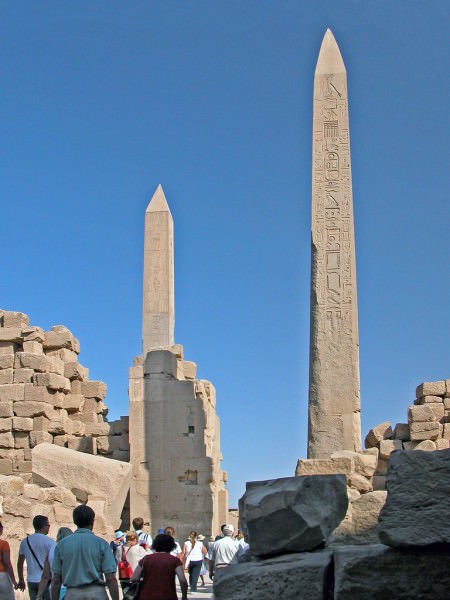
Egyptian Obelisks, Karnak
The Step Pyramid of Djoser was successfully built according to the precepts of the vizier Imhotep (c. 2667-2600 BCE), and when his plans were deviated from by Sneferu during of the Old Kingdom (c. 2613- c. 2181 BCE), the result was the so-called 'collapsed pyramid' at Meidum. Sneferu returned to Imhotep's original engineering plans for his next projects and was able to create his Bent Pyramid and Red Pyramid at Dashur, advancing the art of pyramid building which is epitomized in the Great Pyramid at Giza.
The technological skill required to build the Great Pyramid still mystifies scholars in the present day. Egyptologists Bob Brier and Hoyt Hobbs comment on this:
Because of their immense size, building pyramids posed special problems of both organization and engineering.Constructing the Great Pyramid of the pharaoh Khufu, for example, required that more than two million blocks weighing from two to more than sixty tons be formed into a structure covering two football fields and rising in a perfect pyramidal shape 480 feet into the sky. Its construction involved vast numbers of workers which, in turn, presented complex logistical problems concerning food, shelter, and organization. Millions of heavy stone blocks needed not only to be quarried and raised to great heights but also set together with precision in order to create the desired shape. (217)
In order to accomplish this, the vizier would delegate responsibility to subordinates who would further delegate tasks to others.The bureaucracy of the Old Kingdom of Egypt set the paradigm for the rest of the country's history in accounting for every aspect of a building project and making sure each step was proceeding according to plan. Later in the Old Kingdom, Weni, known as the Governor of the South, would leave an inscription detailing how he traveled to Elephantine for granite for a false door for a pyramid and dug five canals for towboats to bring supplies for further construction (Lewis, 33). Records such as Weni's show the immense amount of effort required in building the monuments one finds in Egypt today. There are numerous inscriptions relating to supplies and difficulties in building the pyramids at Giza but no definitive explanation of the practical means by which they were built.
The most popular theory involves ramps which were constructed as the pyramid was raised but this is actually untenable as Brier and Hobbs note:
The problem is one of physics. The steeper the angle of an incline, the more effort necessary to move an object up that incline. So, in order for a relatively small number of men, say ten or so, to drag a two-ton load up a ramp, its angle could not be more than about eight percent. Geometry tells us that to reach a height of 480 feet, an inclined plane rising at eight percent would have to start almost one mile from its finish. It has been calculated that building a mile-long ramp that rose as high as the Great Pyramid would require as much material as that needed for the pyramid itself - workers would have had to build the equivilent of two pyramids in the twenty-year time frame. (221)
A modification of the ramp theory was proposed by the French architect Jean-Pierre Houdin who claims ramps were used but on the inside of the pyramid, not the exterior. Ramps may have been used externally in the initial stages of construction but then were moved inside. The quarried stones were then brought in through the entrance and moved up the ramps to their position. This, Houdin claims, would account for the shafts one finds inside the pyramid. This theory, however, does not account for the weight of the stones or the number of workers on the ramp required to move them up an angle inside the pyramid.
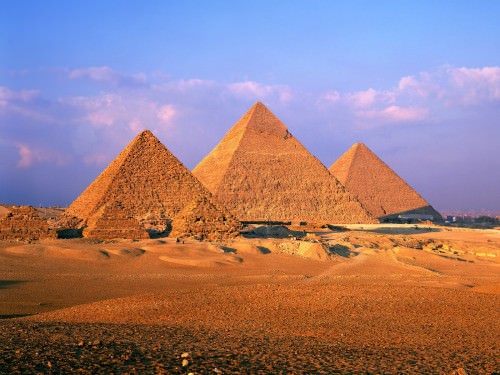
The Pyramids of Giza
A much more cogent theory has been proposed by engineer Robert Carson who suggests that water power was used. It has been clearly substantiated that the water tables of the Giza plateau are quite high and were more so during the period of the Great Pyramid's construction. Water could have been harnessed and pressure exerted via a pump, as Carson claims, to help raise the stones up a ramp to their intended position. Egyptologists still debate the purpose of the shafts inside the Great Pyramid with some claiming they served a spiritual purpose (so the king's soul could ascend to the heavens) and others a practical left over from construction. Egyptologist Miroslav Verner states that these questions cannot finally be answered as we have no definitive texts or archaeological evidence to point in one direction or another.
While that may be so, Carson's claim for water power in construction makes more sense than many others (such as a hoist being used to transport the stones when, clearly, there is no evidence whatsoever for Egyptian use or knowledge of a crane) and it is known that the Egyptians were acquainted with the concept of the pump. King Senusret (c. 1971-1926 BCE) of the Middle Kingdom drained the lake at the center of the Fayyum district during his reign through the use of canals and pumps were used to divert resources from the Nile in other periods. Ukranian engineer Mikhail Volgin also cites water as central to the Great Pyramid's construction and claims that the pyramids were not designed as tombs at all actually but were immense waterworks depots. He points to the lack of any mummies found in the pyramids, their shape, and the high water table of the Giza plateau as evidence for his claim.
AGRICULTURE & ARCHITECTURE
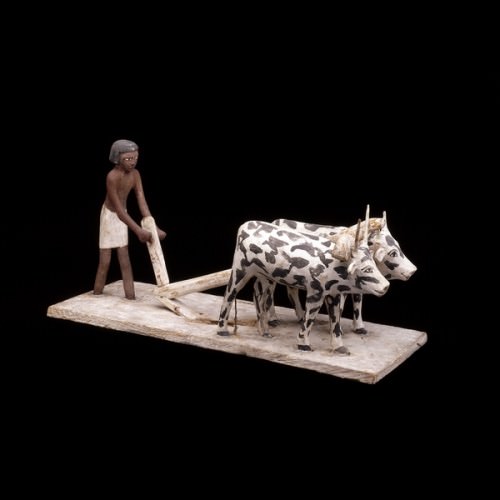
Wooden model of a man ploughing with oxen
Egyptian irrigation techniques were so effective they were implemented by the cultures of Greece and Rome. It has been noted that the Greek philosopher Thales of Miletus (c. 585 BCE) studied in Egypt and may have brought these innovations back to Greece (although he also studied at Babylon and could have learned irrigation techniques there). Irrigation was not an Egyptian invention, however, but was introduced during the Second Intermediate Period by the people known as the Hyksos, who settled in Avaris in Lower Egypt; the Egyptians simply improved upon the techniques. The yearly inundation of the Nile overflowing its banks and depositing rich soil throughout the valley was essential to Egyptian life but irrigation canals were necessary to carry water to outlying farms and villages as well as to maintain even saturation of crops near the river. Historian Margaret Bunson writes:
Early farmers dug trenches from the Nile shore to the farmlands, using draw wells and then the Shaduf, a primitive machine that allowed them to raise levels of water from the Nile into canals...Fields thus irrigated produced abundant annual crops. From the predynastic times agriculture was the mainstay of the Egyptian economy. Most Egyptians were employed in agricultural labors, either on their own lands or on the estates of the temples or nobles. Control of irrigation became a major concern and provincial officials were held responsible for the regulation of water. (4)
Architecture surrounding these canals was sometimes quite ornate as in the case of the pharaoh Ramesses the Great (1279-1213 BCE) and his city of Per-Ramesses in Lower Egypt. Ramesses the Great was one of the most prolific builders in Egyptian history; so much so that there is no ancient site in Egypt which does not make some mention of his reign and accomplishments. In creating his grand monuments, Ramesses' engineers called upon another invention of the Old Kingdom: the corbelled arch. Without the concept of the corbelled arch, architecture the world over would be significantly diminished and some structures, such as the Great Pyramid, would be impossibilities. The grand halls of the temples of Egypt, the inner sanctums, the temples themselves would all have been likewise impossible if not for this advance in engineering and construction.

Abu Simbel
MATHEMATICS & ASTRONOMY
Astronomy was important to the ancient Egyptians on two levels: the spiritual and the practical. Egypt was thought to be a perfect reflection of the land of the gods and the afterlife a mirror image of one's life on earth. This duality is apparent in Egyptian culture in every aspect and epitomized in the obelisk which was always raised in pairs and believed to reflect a divine pair appearing at the same time in the heavens. The stars told the stories of the gods' accomplishments and trials but also indicated the passage of time and the seasons. Egyptologist Rosalie David comments on this:
The Egyptians were noted astronomers who distinguised between the "imperishable stars" (the circumpolar stars) and the "indefatigable stars" (the planets and stars not visible at all hours of the night). They used stellar observations to determine the true north and were able to orientate the pyramids with great accuracy...Each temple was possibly aligned toward a star that had a particular association with the deity resident in that building.(218)
On a more practical level, the stars could tell one when it was going to rain, when it was nearing time to plant or harvest crops, and even the best times for making important decisions such as building a home or temple or starting a business venture.Astronomical observations led to astrological interpretations which may have been adopted from Mesopotamian sources via trade. Strictly astronomical examination of the night skies, however, were interpreted in terms of pragmatism and recorded in mathematical calculations measuring weeks, months, and years. Although the calendar was invented by the ancient Sumerians, the concept was adapted and improved upon by the Egyptians.
MATHEMATICS WAS USED IN RECORD KEEPING, IN DEVELOPING THE SCHEMATICS FOR MACHINES SUCH AS THE WATER PUMP, IN CALCULATING TAX RATES, & IN DRAWING UP DESIGNS & SITING LOCATIONS FOR BUILDING PROJECTS.
According to many Egyptologists, mathematics in Egypt was entirely practical. Rosalie David, for example, claims, "Mathematics served basically utilitarian purposes in Egypt and does not seem to have been regarded as a theoretical science" (217). Ancient writers such as Herodotus and Pliny, however, consistently mention the Egyptians as the source of theoretical mathematics, and they are not the sole sources on this. Many ancient writers, Diogenes Laertius and his sources among them, point to philosophers such as Pythagoras and Plato, who both studied in Egypt, and the importance of mathematical knowledge in their belief systems. Plato regarded the study of geometry necessary for clarity of mind and it is thought he took this concept from Pythagoras who first learned it from the priests in Egypt. In his book Stolen Legacy: The Egyptian Origins of Western Philosophy, scholar George GM James argues western philosophical concepts are falsely attributed to the Greeks who merely developed Egyptian ideas, and this same paradigm may hold for the study of mathematics as well.
There is no doubt that the Egyptians used mathematics on a daily basis for far more mundane purposes than the pursuit of ultimate truths. Mathematics was used in record keeping, in developing the schematics for machines such as the water pump, in calculating tax rates, and in drawing up designs and siting locations for building projects. Mathematics was also used on a very simple level in the medical arts in writing prescriptions for patients and mixing the ingredients for medicines.
MEDICINE & DENTISTRY
Medicine in ancient Egypt was intimately tied to magic. The three best-known works dealing with medical issues are the Ebers Papyrus (c. 1550 BCE), the Edwin Smith Papyrus (c. 1600 BCE), and the London Medical Papyrus (c. 1629 BCE) all of which, to one degree or another, prescribe the use of spells in treating diseases while at the same time exhibiting a significant degree of medical knowledge.
The Ebers Papyrus is a text of 110 pages treating ailments such as trauma, cancer, heart disease, depression, dermatology, gastrointestinal distress, and many others. The Edwin Smith Papyrus is the oldest known work on surgical techniques and is thought to have been written for triage surgeons in field hospitals. This work shows detailed knowledge of anatomy and physiology. The London Medical Papyrus combines practical medical skill with magical spells for the treatment of conditions ranging from eye problems to miscarriages.
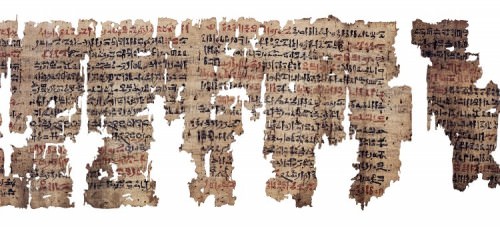
The London Medical Papyrus
Medical texts, other than these, also give prescriptions for dental problems. Herodotus notes that doctors in Egypt were all specialists in their particular field and this applied to dentists as well as any other. There was a position known as "One Who is Concerned with Teeth", regarded as a dentist and another known as "One Who Deals with Teeth" who may have been a kind of pharmacist. The dentist was often called upon to pull a tooth but it seems that oral surgery was seldom performed. Most of the medical texts dealing with dental issues are preventative or related to pain management.
Based on the evidence of mummies who have been examined, as well as letters and other documents, ancient Egyptians seem to have experienced fairly severe and widespread dental problems. Dentistry does not seem to have evolved at the same pace as other branches of medicine but still was more advanced and showed a greater knowledge of dealing with oral pain than later remedies practiced by other cultures. The first known dental procedure dates to 14,000 years ago in Italy, according to evidence published in 2015 CE, but the first dentist in the world known by name was the Egyptian Hesyre (c. 2660 BCE) who held the position of Chief of Dentists and Physician to the King during the reign of Djoser (c. 2670 BCE) showing that dentistry was considered an important practice as early as Djoser's reign and probably earlier. This being so, it is unclear why dental practices did not evolve to the same degree as other medical fields.
Artwork and many medical texts seem to largely ignore dental problems and toothaches, but non-medical texts address them as most likely caused by a tooth-worm which needed to be driven away by magical spells, extraction, and applying an ointment. This belief most likely came from Mesopotamia, specifically Sumer, as an ancient text from that region predates the Egyptian concept of the tooth-worm. Medical tools have been found which could have been used by dentists, but as none are labeled or referred to clearly in texts, one cannot say for certain. It is clear, however, that dentists had the ability to diagnose oral disease and the technology to operate on gums and teeth.
ART & LITERATURE
Technology also influenced Egyptian art and literature, not only in how it was produced but in content and form. Obviously, the invention of papyrus and ink greatly facilitated writing and advances in copper tools replacing flint in carving improved quality of art; but the world the Egyptians created through their understanding of scientific measurements and technological advancements became both the subject and the canvas artists worked on.
The Poem of Pentaur, for example, which narrates the victory of Ramesses the Great over the Hittites at Kadesh, is not simply written on a sheet of papyrus or a plaque but proclaimed from the sides of temples in Abydos, Karnak, Abu Simbel, and his Ramesseum. The form the artist worked in, the stone of the temple, informs the content of the piece itself: Ramesses' great victory against overwhelming odds. The story is more impressive for the medium in which it is told.
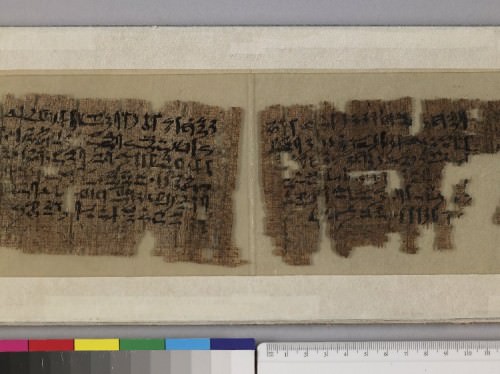
Tale of Sinuhe (Berlin 10499)
This same is true for the stelae, obelisks, and other monuments throughout Egypt. The literature which is inscribed on these stone pieces gives them their own life while imbuing the story itself with greater meaning as both literary and visual art. In written texts, of course, technological advances appear constantly in stories whether The Tale of Sinuhe where the narrator speaks of his travels in other lands and what he finds lacking there or the Tale of the Shipwrecked Sailor where the technology of shipbuilding makes the story possible.
Los antiguos egipcios creían que el equilibrio, la armonía en todos los aspectos de la vida era lo más importante y este valor puede verse en casi todos sus avances en las ciencias y la tecnología: lo que faltaba en la vida se equilibraba con lo creado por el ingenio individual. Aunque se pensaba que los dioses habían proporcionado todas las cosas buenas a los seres humanos, todavía era responsabilidad de un individuo cuidar de uno mismo y de la comunidad en general. A través de sus inventos y avances en el conocimiento, los egipcios habrían creído que estaban haciendo la voluntad de Dios para hacer aún mejor la gran vida y el mundo que les habían dado.
LICENSE
Article based on information obtained from these sources:with permission from the Website Ancient History Encyclopedia
Content is available under License Creative Commons: Attribution-NonCommercial-ShareAlike 3.0 Unported. CC-BY-NC-SA License
